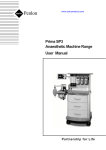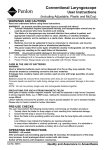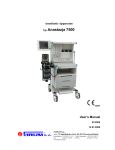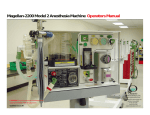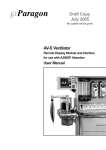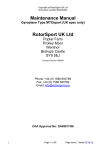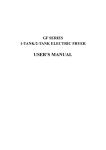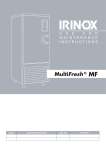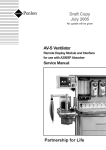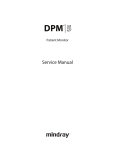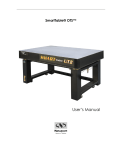Download A200SP User Manual 2009
Transcript
A200SP Circle Absorber User Manual Partnership for Life IMPORTANT Servicing and Repairs In order to ensure the full operational life of this device, servicing by an engineer trained by the manufacturer should be undertaken periodically. We recommend that the absorber should be serviced on the following schedule: (a) Six monthly inspection and function testing. (b) Annual service which includes routine replacement of seals etc, as preventive maintenance. Details of these operations are in the A200SP Circle Absorber service manual, which contains servicing procedures etc. Servicing should be carried out by engineers trained by Penlon Ltd. For any enquiry regarding the servicing or repair of this device, contact the nearest accredited Penlon agent: or communicate directly with: Technical Support Department Penlon Limited Abingdon OX14 3PH UK Tel: 44 (0) 1235 547076 Fax: 44 (0) 1235 547062 E-mail: [email protected] Always give as much of the following information as possible: 1. Type of equipment 2. Product name 3. Serial number 4. Approximate date of purchase 5. Apparent fault (i) FOREWORD IMPORTANCE OF PATIENT MONITORING This manual has been produced to provide authorised personnel with information on the function, routine, performance and maintenance checks applicable to the A200SP Absorber. WARNING Anaesthesia systems have the capability to deliver mixtures of gases and vapours to the patient which could cause injury or death unless controlled by a qualified anaesthetist. Information contained in this manual is correct at the date of publication. The policy of the manufacturer is one of continued improvement to their products. Because of this policy the manufacturer reserves the right to make any changes which may affect instructions in this manual, without giving prior notice. There can be considerable variation in the effect of anaesthetic drugs on individual patients so that the setting and observation of control levels on the anaesthesia system does not in itself ensure total patient safety. Anaesthesia system monitors and patient monitors are very desirable aids for the anaesthetist but are not true clinical monitors as the condition of the patient is also dependent on his respiration and the functioning of his cardio-vascular system. Personnel must make themselves familiar with the contents of this manual and the machine function before using the apparatus. IT IS ESSENTIAL THAT THESE ELEMENTS ARE MONITORED FREQUENTLY AND REGULARLY AND THAT ANY OBSERVATIONS ARE GIVEN PRECEDENCE OVER MACHINE CONTROL PARAMETERS IN JUDGING THE STATE OF A CLINICAL PROCEDURE. Copyright © Penlon Ltd 2009 All rights reserved. Before using any monitoring system or device, the user must check that it conforms to the relevant standard, as listed in the table below. Parameter / Device Relevant Standard Pressure Measuring Pressure Limitation Device Exhaled Volume Monitor Breathing System Integrity Alarm System Continuing Pressure Alarm Oxygen Monitor Carbon Dioxide Monitor Breathing Circuit Agent Monitor Gas Scavenging ISO 8835-2 EN 60601-2-13:2006 EN 60601-2-13:2006 EN 60601-2-13:2006 EN 60601-2-13:2006 ISO 7767 ISO 9918 ISO 8835-2 ISO 11196 ISO 8835-3 - 51.101.1 51.101.4 51.101.5 51.101.6 For information on installing and connection of any of these systems or devices, please refer to the relevant manufacturer’s instructions. (ii) CONTENTS Page No. USER RESPONSIBILITY 1 1. WARNINGS AND CAUTIONS 2 2. PURPOSE 4 3. DESCRIPTION 3.1 3.2 3.3 3.4 3.5 3.6 3.7 3.8 3.9 3.10 3.11 Canisters Inspiratory and Expiratory Non-return Valves (NRV) Bag/Ventilator Switch Adjustable Pressure Limiting (APL) Valve Fresh Gas Inlet and Tubing Manometer Heater (option) Bypass Flow End Tidal Carbon Dioxide Monitoring Interface to AV-S Ventilator Gas Flow Diagrams 4. SPECIFICATION 4.1 General Dimensions and Weight 11 4.2 Resistance of Breathing System 11 4.2.1 Expiratory Resistance 11 4.2.2 Inspiratory Resistance 11 4.3 Internal Compressible Volume 11 4.4 System Leakage Rate 12 4.5 Canister Capacity and Resistance 12 4.5.1 Canister Capacity 12 4.5.2 Canister Resistance 12 4.6 Non-return valves 12 4.7 Mode of Operation 12 4.8 Heater (option) 13 4.9 Device Classification and Labelling 13 4.10 Environmental 13 5. INSTALLATION AND OPERATION 5.1 5.2 5.3 5.4 5.5 Mounting the Absorber System Connections Changing CO2 Absorbent Manometer Heater (option) 6. PRE-USE CHECKS 6.1 6.2 6.3 6.4 6.5 6.6 Pre-use Checklist Leak Test APL Valve Test and Pressure Relief Valve Test Non-return Valve Test Bag/Ventilator Switch Test Leak Test - Canister Removed 6 6 6 7 7 8 8 8 8 9 10 14 15 17 18 18 (iii) 19 20 20 21 21 22 CONTENTS Page No. 7. MAINTENANCE 7.1 Service Frequency 23 7.2 Canisters and Seals 23 7.3 Condensate Drainage 24 7.4 Manometer 24 7.5 APL Valve 24 8. STERILISATION 8.1 Sterilisation Policy 25 8.2 Bacterial Filters 25 8.3 Patient Circuit Components 25 8.4 Absorber Assembly 26 8.5 8.6 Sterilisation and Disinfectant Treatment Table Absorber Assembly - Reassembly after Cleaning and Sterilisation 28 29 9. APPENDIX 1. Disposal after use . . . . . . . . . . . . . . . . . . . . . . . . . . . . . . . . . . . . . . . . . . . 30 2. Approved Accessories . . . . . . . . . . . . . . . . . . . . . . . . . . . . . . . . . . . . . . . 31 (iv) USER RESPONSIBILITY Statements in this manual preceded by the following words are of special significance:- This device has been built to conform with the specification and operating procedures stated in this manual and/or accompanying labels and notices when checked, assembled, operated, maintained and serviced in accordance with these instructions. To ensure the safety of this device it must be checked and serviced to at least the minimum standards laid out in this manual. A defective, or suspected defective, product must not under any circumstances be used. The user must accept responsibility for any malfunction which results from non-compliance with the servicing requirements detailed in this manual. Additionally, the user must accept responsibility for any malfunction which may result from misuse of any kind, or non-compliance with other requirements detailed in this manual. WARNING means there is a possibility of injury to yourself or others. CAUTION means there is a possibility of damage to the apparatus or other property NOTE indicates points of particular interest for more efficient and convenient operation. The reader must take particular notice of the warnings, cautions and notes provided throughout this manual Worn, broken, distorted, contaminated or missing components must be replaced immediately. Should such a repair become necessary it is recommended that a request for service advice be made to Penlon Limited or the nearest Penlon Service Centre. This device and any of its constituent parts must be repaired only in accordance with written instructions issued by Penlon Limited and must not be altered or modified in any way without the written approval of Penlon Limited. The user of this equipment shall have the sole responsibility for any malfunction which results from improper use, maintenance, repair, damage or alteration by anyone other than Penlon Limited or its appointed agents. USA and Canadian Federal Law restricts the sale and use of this device to, or on the order or, a licensed practitioner. 1 1. WARNINGS AND CAUTIONS The following WARNINGS and CAUTIONS must be read and understood before using this Anaesthetic Apparatus 8. Underfilling of the canister can lead to inefficient CO2 absorption. Overfilling may result in poor sealing of canister due to caking of granules and abrasion of the canister and seal. See 3.1 and 5.3. 9. Anhydrous soda lime is known to react with some anaesthetic agents. Do not continue to use an absorbent if it has been allowed to dry out (or if you suspect it has dried out). Always replace dried-out absorbent with a fresh supply of soda lime. 10. Do not use the Absorber without ensuring that it passes all pre-use checks. See Section 6. 11. After servicing and cleaning procedures, verify positive action of the bag/ventilator selector switch before the unit is used clinically. WARNINGS General Information 1. Personnel must make themselves familiar with the contents of this manual and the function of the A200SP Absorber before use. 2. Trichloroethylene must not be used in association with soda lime. 3. This unit is restricted to use with nonflammable anaesthetic agents only. 4. The A200SP Circle System Absorber must only be used when securely mounted in an upright position. a) The inspiratory and expiratory nonreturn valves (NRV) are gravity operated. b) Spillage of absorbent may contaminate the breathing system. See 3.2 / 5.1 Check that at all times that the switch is free to move from one end of its travel to the other. Using the absorber 12. Condensation, which may collect in the bottom of the absorber canister is caustic and care must be taken not to spill it on the skin when draining. See section 7.3. 13. Kinking of the fresh gas tube is a known cause of anaesthetic accident and the use of unsuitable tubing can contribute to this situation. See 3.5. 14. Any breathing system utilising the A200SP absorber must be fitted with: a) An oxygen monitor complying with ISO7767. b) A minute volume monitor. c) A breathing system integrity alarm. 15. Refitting the canister: Ensure that the top of the canister engages correctly into the seal in the absorber as you rotate the lever anticlockwise to the locked-on position. Before using the absorber 5. 6. 7. The use of patient Y-pieces containing non-return valves in connection with the Absorber is hazardous, because two sets of nonreturn valves may easily be connected in opposition, by error. Breathing hoses and bags used with the absorber must comply to ISO 5367 (Hoses) and ISO5362 (Breathing Bags) respectively. The resistance and compliance of these hoses and bags provide essential factors for the satisfactory use of this system. Do not connect a vacuum systems must not directly to the APL valve. A receiving system with positive and negative pressure control functions must be interposed. Systems must comply with ISO 8835 Part 2. See 5.2.3. Failure to lock the canister in the fully closed position, may cause a system leak and/or a reduction in CO2 absorption. (see 5.3). 2 WARNINGS AND CAUTIONS 16. Heater unit (if fitted): exterior panels must not be removed by unauthorised personnel, and the unit must not be operated with such panels missing. There is a possible electric shock hazard. CAUTIONS 1. Do not sterilise manometer. 2. Do not allow any liquid to run into the electrical interface unit at the rear of the absorber. Do not autoclave 3. Do not allow any liquid to run into the heater unit (if fitted). Do not autoclave. 4. Autoclaving the absorber canister: Discard the absorbent and drain the condensate from the canister, then refit the canister to the absorber assembly, before autoclaving (see section 8.4). 5. If the absorber has to be lifted or carried by hand, always support the weight of the unit under the base. Do not lift the absorber by gripping any of the components attached to the top of the absorber - the manometer, APL valve, breathing circuit connectors, etc. 6. Do not use any ventilator with the A200SP absorber that does not comply with ISO 8835 part 2. User Maintenance 17. User maintenance is restricted to cleaning the outside surfaces of the ventilator, see section 7. Other procedures detailed in this manual must be carried out by trained technicians. Service and repair operations must only be carried out by an engineer trained by the manufacturer. The warranty for this product is void if the product is not maintained in accordance with the service schedule detailed in section 7.1, and the procedures published in the Service Manual for this product. 3 (autoclave) the 2. PURPOSE The A200SP Absorber is designed for use as part of a closed breathing system for anaesthesia, providing CO2 absorption in conjunction with the appropriate ventilator, breathing hoses, reservoir bags and patient connections. Depending on the flow of fresh gas relative to patient minute volume, the patient may receive fresh gas or partial recirculated gas, as determined by the anaesthetist. The system incorporates a Bag/Ventilator switch to enable: a) spontaneous breathing or manually assisted ventilation in ‘Bag’ mode. b) use with an anaesthesia ventilator when ‘Ventilator’ is selected. 4 7 8 11 1 2 5 4 3 12 10 6 9 A200SP Circle System Absorber 1. Adjustable pressure limiting valve (APL valve) 7. Ventilator bellows housing 2. Inspiratory non-return valve (NRV) 8. Electrical interface unit 3. Inspiratory hose connector 9. Expiratory hose connector 4. Bag/ventilator switch 10. Expiratory non-return valve (NRV) 5. Reservoir bag connector 11. Manometer 6. Canister 12. Canister release lever 5 3. DESCRIPTION 2 3 1 2 1 3.1 3.2 Canister (1) Inspiratory and Expiratory Non-return Valves (NRV) Mounting The valves are positioned on the top of the manifold block and control the direction of the gas flow through the system. The absorber must only be used when securely mounted in an upright position – spillage of absorbent may contaminate the breathing system – see WARNING, in section 5.1. Each valve consists of a disc located over a valve seat. The discs operate by gravity and are retained by guides to prevent lateral movement. Canister Release/Lock System The canister release/lock mechanism is operated by a lever (2) at the base of the canister assembly. Swivel the front of the absorber assembly away from the side of the anaesthetic machine, and turn the lever clockwise to release the canister. Note: the illustration shows the canister in the unlocked position. The valves are visible through the top cover (2) and the operation of each valve can be visually checked as the patient breathes in and out. IT IS IMPORTANT THAT THE ABSORBER IS MOUNTED UPRIGHT SO THAT THE VALVE DISCS MOVE IN A TRULY VERTICAL PLANE, WITH THE VALVE SEATS HORIZONTAL. Absorbent Capacity The canister (1) is designed to take a prepacked unit, or hold 1.3 kg (equivalent to 1500 ml) of loose absorbent in its inner container. 3.3 Bag/Ventilator Switch (3) The switch (3) can be set to bag or ventilator positions. NOTE Remove the inner container from the canister if a pre-pack unit is to be used. Ventilator mode In ‘Ventilator’ mode the reservoir bag is closed off from the breathing system and the ventilator connection port at the rear of the manifold block, is in circuit. DO NOT OVERFILL the inner container - see section 5.3. Refill During Use The canister seals at the top face. The canister can be removed and refilled during a clinical procedure. WARNING The APL valve is out of circuit when the system is in ‘Ventilator’ mode. The ventilator must be equipped with a pressure relief valve. WARNING If the absorbent is to be changed during clinical use, adequate fresh gas flow must be maintained to prevent excessive build up of CO2. Bag mode The breathing bag acts as an additional overpressure protection device, preventing pressure exceeding 60 cmH2O. Gas Flow WARNING If no ventilator is connected to the absorber, care must be taken to ensure that the bag/ ventilator switch is kept in the ‘Bag’ position, to avoid gross loss of gas from the breathing system and to maintain the reservoir bag in the system. Gas flows through the canister from top to bottom. Note that the bag/ventilator connection is between the absorber and the patient. Bag squeezing or the use of mechanical ventilation does not result in the transport of dust toward the patient, but tends to drive dust back into the absorber. 6 DESCRIPTION 3.4 Adjustable Pressure Limiting (APL) Valve The APL valve is a spring loaded plastic float with a rubber seal, providing breathing system pressure control, and excess pressure relief. The spring pressure can be varied by rotating the control knob on top of the valve. In the fully counterclockwise position the minimum pressure is 1.0 cmH2O at 6 L/min. This can be increased by clockwise rotation to 60 cmH2O. 60 Pressure (cmH2O) Open Closed Clockwise rotation As shown in the graph above, further clockwise rotation causes a rapid increase in opening pressure so that in the fully closed position, the valve functions as a 60 cmH2O excess pressure relief valve. AGSS connector Taper connector (1) at rear of absorber assembly. 3.5 Fresh Gas Inlet and Tubing The fresh gas inlet (2) is at the rear of the absorber. The absorber is supplied with a fresh gas hose assembly with attached end fitting. Do not use any other type of hose 1 WARNING Kinking of the fresh gas tube is a known cause of anaesthetic accident and the use of unsuitable tubing can contribute to this situation. 2 7 DESCRIPTION 3.6 NOTE: Manometer The use of a manometer is strongly recommended at all times. The manometer (1) is located on the top of the manifold block to the rear of the expiratory valve . Manometer scale: –10 to +100 cmH2O Manometer accuracy: ±5% (within range +10 to 80 cmH2O) 1 CAUTION Remove the manometer before autoclaving the absorber unit. 3.7 2 Heater Unit (option) The heater unit (2) limits the build up of moisture in the gas paths through the absorber. The heater operates automatically when mains power is connected (see section 5.5). CAUTION Do not autoclave the heater unit. 3.8 Bypass System The absorber reverts to bypass mode when the lever is turned clockwise to release the canister. Expiratory gas cycles to the patient, without passing through the absorbent. It is strongly recommended that a capnometer is used to prevent the risk of hypercapnia. 3.9 End Tidal Carbon Dioxide Monitoring The use of end tidal carbon dioxide monitoring is strongly recommended. Connection of a suitable analyser must be made between the patient’s airway and the patient connection Y-piece. Detailed instructions are provided manufacturers of the analyser. by the 8 DESCRIPTION 3.10 Interface to AV-S Ventilator 1 The absorber is designed to interface with the AV-S Ventilator and the ventilator bellows unit (1) is built into the absorber. The interface cable links the connector (2) on the ventilator control panel to the multifunction connector (3) on the interface unit at the rear of the absorber. a) The A200SP is fitted with fitted with a sensor that detects the position of the absorber bag/vent control switch (4). A mechanical link actuates the sensor and the signal cabling is routed internally to connector (3) b) Operation of the Bag/Vent control will trigger automatic Mode switching on the AV-S ventilator, as follows: 4 i) Ventilator in Volume or Pressure mode Switching the absorber Bag/Vent control from Vent to Bag - the ventilator will change from Volume Mode, or Pressure Mode, into Spontaneous Mode. 2 ii) Ventilator in Spontaneous Mode Switching the absorber control from Bag to Vent Bag/Vent Note that the mode switching operation is dependant on the original selection process used to reach Spontaneous Mode: A) If the ventilator was previously in Volume, or Pressure, or Special Mode, and Spontaneous Mode was automatically selected by the operation of the bag/vent control (from Vent to Bag, as described above): - the ventilator will now revert to that previous mode. B) If the ventilator was in Standby Mode, and Spontaneous Mode was selected onscreen: - the ventilator will revert to Volume Mode. NOTE a) operation of the absorber Bag/Vent control will have no effect on the ventilator unless the above conditions are met. b) This function can be enabled/disabled through the on-screen Service sub-menu (see appendix, in the ventilator user manual). 9 3 DESCRIPTION 3.11 Gas Flow E Inspiratory Gas Path A. B. C. D. E. F. G. A Patient Gas from bellows Through the bag/vent switch Down to absorbent canister Through the absorbent Fresh gas flow from anaesthetic machine Into the inspiratory non-return valve Through inspiratory connector to patient breathing circuit B C F D G 1 7 6 A200SP Absorber Gas Flow Schematic 12 13 2 13 14 4 1. 2. 3. 4. 3 16 16 17 15 11 9 5 10 8 10 5. 6. 7. 8. 9. 10. 11. 12. 13. 14. 15. 16. 17. Ventilator Bellows Bag/vent switch Absorbent canister Fresh gas flow from anaesthetic machine Inspiratory non-return valve APL valve Breathing bag Patient Expiratory non-return valve Manometer Pressure monitor sample line Ventilator drive gas Absorbent bypass valves Absorbent bypass line Oxygen monitor sensor Spirometer flow sensors Canister release mechanism 4. SPECIFICATION NOTE: Information in this section complies with the requirements of ISO 8835–2. 4.1 General Dimensions All figures are approximate Overall height Width Depth 380 mm 186 mm 240 mm Weight (empty) 5.7 kg Mounting system Polemount assembly 4.2 Resistance of Breathing System Resistances listed in 4.2.1 and 4.2.2 are measured with: (A) An absorber fitted with 1060 mm (42 inch) breathing hoses complying with ISO 5367, and a Safelock Y-piece. (B) Absorber only. NOTE: 1. The canister must be filled to the correct level with fresh absorbent (follow the instructions in section 5.3). 2. A bacterial filter must be used in the patient breathing system to protect the oxygen sensor. Use an appropriate filter that does not raise the resistance values of the whole system to above 0.6 kPa (6 cmH2O). 3. 4.2.1 The APL valve must be fully open. Expiratory Resistance Tested with a flow of 6 L/min of air through the fresh gas inlet and an induced flow of 60 L/min through the breathing system. (A) expiratory resistance: less than 0.6 kPa (6 cmH2O) (B) expiratory resistance: less than 0.5 kPa (5 cmH2O) 4.2.2 Inspiratory Resistance Tested with a flow of 6 L/min of air through the and an induced flow of 60 L/min through the breathing system. (A) (B) 4.3 fresh gas inlet inspiratory resistance: less than 0.6 kPa (6 cmH2O) inspiratory resistance: less than 0.45 kPa (4.5 cmH2O) Internal Compressible Volume Note that the reservoir bag is not fitted and the bag mount blocked. These figures are measured with: (A) An absorber fitted with 1060 mm (42 inch) breathing hoses complying with ISO 5367, and a Safelock Y-piece. Volume required to raise the system pressure to 3 kPa (30 cmH2O) = 180 ml (B) Absorber only. Volume required to raise the system pressure to 3 kPa (30 cmH2O) = 170 ml Other disposable breathing hoses may give different figures; the supplier of the hose will provide compressible volume figures. 11 SPECIFICATION 4.4 System Leakage Rate The patient connection port is sealed and the APL valve fully closed. These figures are measured with: (A) An absorber fitted with 1060 mm (42 inch) breathing hoses complying with ISO 5367, and a Safelock Y-piece. Absorber ‘ON’ Leakage rate: less than 50 ml/min at 3 kPa (30 cmH2O) (B) Absorber only. Absorber ‘OFF’, canister removed. Leakage rate: less than 50 ml/min at 3 kPa (30 cmH2O) 4.5 Canister Capacity and Resistance 4.5.1 Canister Capacity When filled to the correct level (see section 5.3), the canister inner container holds 1.3 kg (2.87 lb) of absorbent (1500 ml). Recommended absorbent: Soda lime, with a colour indicator, 4-8 mesh. Use bulk packed (loose) or pre-packs. Note i) ii) 4.5.2 The absorber canister is not electrically conductive. Cleaning and sterilisation details are given in section 8. Canister Resistance The resistance of a freshly filled canister is less than 0.2 kPa (2 cmH2O) at 60 L/min. 4.6 Non-return Valves Pressure drop across the inspiratory and expiratory nonreturn valves at an air flow of 60 L/min: 0.1 kPa (1 cmH2O). 60 Flow (L/min) 50 40 Note that flow characteristics are identical for valves in a dry or wet condition. A ‘wet’ valve is defined as a valve in a flow of humidified gas, such that moisture is visible on the surface of the valve. 30 20 10 Pressure (kPa) 0.02 4.7 Mode of Operation Mode of Operation: Continuous 12 0.04 0.06 0.08 0.1 SPECIFICATION 4.8 Heater (option) Voltage 110 - 240 VAC Current 1.5 - 0.7 A Frequency 50/60 Hz Fuse T2 AH 250 V Electro-magnetic compatibility: The A200SP meets the requirements of EN60601-1-2 (Electromagnetic compatibility - requirements and tests). 4.9 Device Classification and Labelling Type B Applied Part Degree of protection against electric shock This symbol denotes: Type B equipment: Class 1 Classification Type of protection against electric shock Class 1 IPX0 Ingress protection Classification according to the degree of protection against ingress of water IPX0 (not protected) Labelling This symbol denotes: Refer to the User Manual 4.10 Environmental Operating: Temperature Humidity Altitude Air Pressure MRI compatibility 15 to 30oC (59 to 86oF) 10 - 95% RH (relative humidity), non-condensing Up to 2775 m (9000 feet) 70 - 110 kPa The A200SP absorber is not suitable for use in an MRI environment Electro-magnetic compatibility: The A200SP meets the requirements of EN60601-1-2 (Electromagnetic compatibility - requirements and tests). Storage and Transport: Temperature Humidity Air Pressure -5 to 40oC (23 to 104oF). 10 - 95% RH (relative humidity), non-condensing 11.5 - 110 kPa Disposal at end of useful life - risk assessment There are no risks associated with disposal of this product. Follow your hospital, local, state and federal regulations. 13 5. INSTALLATION AND OPERATION 2 1 5.1 Mounting the Absorber NOTE Heater option illustrated. CAUTION If the absorber has to be lifted or carried by hand, always support the weight of the unit under the base. Do not lift the absorber by gripping any of the components attached to the manifold block at the top of the absorber. WARNING The absorber assembly must only be used when securely mounted in an upright position. a) Non-return valves are gravity operated b) Spillage of absorbent may contaminate the breathing system. Polemount bracket assembly (1) Secure the polemount assembly to the side of the anaesthetic machine. Mount the absorber on the bracket assembly, and secure by tightening the knob (2). Height Adjustment Slacken the knob (2) and position the assembly at the required height. Tighten the knob. 14 INSTALLATION AND OPERATION 5.2 System Connection Hoses and Cables Schematic: AV-S and A200SP Absorber 25 3 26 23 24 2 20 19 18 Note 12 1. AV-S has spirometry and oxygen monitor. 2. Interface cabling is shown for Prima SP2 On/Off switch and A200SP Bag/Vent switch. 1 4 11 10 21 16 27 14 29 26 13 28 15 5 17 22 12 6 9 7 8 Note a) AV-S has spirometry and oxygen monitor. b) Interface cabling is shown for Prima SP2 On/Off switch and A200SP Bag/Vent switch. 15. Inlet - from Ventilator Bellows 16. Connector - Reservoir Bag 17. Inlet - Absorber - Fresh Gas Supply 18. Drive Gas Inlet - Ventilator 1. Bellows 19. Drive gas Outlet - ventilator control unit to bellows 2. Ventilator Control Unit 20. Outlet - Exhaust Valve 3. Outlets to Anaesthetic Gas Scavenging System (AGSS) 21. Inlet - Bellows Drive Gas 4. Bacterial Filter 22. Outlet - to breathing system 5. Absorber valve block 23. Input socket - Oxygen monitor sensor 6. Heat and moisture exchanger 24. Input socket - Prima SP2 interface 7. Patient 8. CGO on anaesthetic machine (Fresh Gas Supply) 25. Input socket: 9. Auxiliary Outlet on anaesthetic machine (Drive Gas Supply) 10. Flow sensor - expiratory 11. Flow sensor - inspiratory 26. Interface connections on Prima SP2 and A200SP 12 Connectors - sensor - pressure monitor 27. APL Valve 13. Expiratory Valve - Absorber 28 Outlet from APL Valve to AGSS 14. Inspiratory Valve - Absorber 29 (SP on/off switch) (i) A200SP Absorber Bag/Vent control position (ii) Spirometer sensor signal 15 Oxygen sensor INSTALLATION AND OPERATION 5.2.1 a) b) Breathing System Inspiratory (1) and expiratory (2) hose connectors and the reservoir bag connector (3) are 22 mm male, complying with ISO 5356/1. 3 Use a heat and moisture exchanger (HME) at the patient Y piece. 11 CAUTION Replacement/Disposal - always follow the instructions supplied with the filter or HME. Fit new components at the recommended interval. c) The bag arm is height adjustable, and the bag connector can be rotated to the desired position d) Ventilator connection point (4): Connect a 17 mm diameter corrugated hose between the ventilator control unit drive gas outlet (labelled: DRIVE GAS) and the connector (4) at the rear of the absorber. 5.2.2 7 2 1 8 Fresh Gas Supply Connect the fresh gas hose from the common gas outlet of the anaesthetic machine assembly at (5). 5.2.3 Anaesthetic Gas Scavenging (AGS) The outlet (6) from the APL valve (7) must be connected to a receiver system. WARNING Do not connect a vacuum system directly to the APL valve. A receiving system with a positive and negative pressure control function must be interposed. The receiving system must comply with the requirements of ISO 8835 part 2. 5.2.4 Oxygen Monitor The use of an oxygen monitor (and a carbon dioxide analyser) is highly recommended when using any partial rebreathing anaesthetic system. The sensor (8) is fitted to the right hand side of the absorber. Bacterial Filter Use a breathing system bacterial filter in the expiratory limb of the breathing circuit to protect the oxygen sensor (see section 5 in the AV-S user manual). CAUTION Replacement/Disposal - always follow the instructions supplied with the filter, and always replace at the recommended interval. 5.2.5 Pressure Monitor Pressure monitor self-sealing connector (9). Connect to PATIENT PRESSURE port on the rear panel of the AV-S ventilator control unit. 5.2.6 Bag/Vent Switch and Spirometer The multifunction connector (10) provides an interface between the AV-S ventilator and: (a) the spirometer flow sensors, and (b) the sensor that detects the position of the Bag/Ventilator switch (11) . 16 10 6 4 9 5 INSTALLATION AND OPERATION 5.3 Changing CO2 Absorbent WARNING If the absorbent is to be changed during clinical use, adequate fresh gas flow must be maintained to prevent excessive build up of CO2. WARNING Anhydrous soda lime is known to react with some anaesthetic agents. Do not continue to use the absorbent if it has been allowed to dry out (or if you suspect it has dried out). Always replace dried-out absorbent with a fresh supply. Removing the canister WARNING Condensation, which may collect in the bottom of the absorber canister, is caustic. Avoid skin contact when draining. 1. Swivel the front of the absorber assembly away from the side of the anaesthetic machine. 2. Turn the lever (1) clockwise to release the canister (2) . 3. Check the level of liquid in the canister. Carefully lift out the inner absorbent container (3) or pre-pack unit. WARNING Condensate may drip from the container or pre-pack. Use a cloth to prevent spillage. 4. Dilute the liquid in the canister with water before disposal. Follow your hospital procedure. 5. Dispose of the pre-pack, or the absorbent from the inner container (3) in compliance with your local disposal procedures. 1 2 3 Cleaning Soda lime tends to adhere strongly to surfaces when it has become exhausted. 2 To maintain good sealing, the canister, absorbent container, seal, and the sealing plate above the canister should be wiped with a damp cloth to remove particles of soda lime, whenever the absorbent is changed. 4 Refilling with absorbent 1. Pre-packed soda lime: Check that the three spacers (4) are in place. Check that the carrier (5) is in place Check the manufacturer’s included with the pre-pack. instructions 5 Remove the packaging and insert the new prepack into the carrier in the canister. 17 INSTALLATION AND OPERATION 2. 4 3 Bulk packed (loose) soda lime: WARNING Underfilling can lead to inefficient CO2 absorbtion. Overfilling may result in poor sealing of the canister, due to caking of granules and abrasion of the canister seal. 25 mm Check that the container (3) is clean and dry and empty of dust or soda lime granules. Place the container on a horizontal surface and fill it with soda lime up to a level 25 mm (1 inch) below the top. Do not fill above this level. Check that the three spacers (4) are fitted, and place the container in the canister. Refitting the canister 1. Fit the canister (2) and check that it is located centrally within the base plate (6). Turn the lever (1) anti-clockwise to lock the canister in place. The top of the canister must engage correctly into the seal (7) as you rotate the lever anticlockwise to the locked-on position. 6 2 7 WARNING Failure to lock the canister in the fully closed position, may cause a system leak and/or a reduction in CO2 absorption. 2. 1 Leak test the absorber – see section 6.2. 5.4 Manometer The manometer (1) is located on the top of the manifold block, to the rear of the inspiratory valve. If the manometer has been removed and refitted, function test the absorber, checking for leaks at the manometer, before clinical use. 1 CAUTION Remove the manometer before autoclaving the absorber unit. 5.5 Heater (option) Connect the cable (mains electrical supply) to the socket (1) on the back of the heater unit (2). Secure the cable with the safety clip (3). The heater operates automatically, and the warning lamp (4) is illuminated, when mains power is connected. The heater has a thermostatic control system. CAUTION Do not immerse or autoclave the heater assembly. Remove the unit before the absorber assembly is cleaned and sterilised (see section 8.4). 18 1 3 4 2 6. PRE-USE CHECKS 6.1 Pre-use Checklist 1. Check the absorbent, replace if necessary. Before refitting the canister, check that the sealing surfaces are clean and dust free. Ensure that the canister is fully rotated and seals securely when refitted (see 5.3). 2. Check that the fresh gas hose is connected to the anaesthetic machine. Note that the anaesthetic machine must be leak tested before the absorber pre-use checks are made. 3. Leak test the absorber – see section 6.2 4. Carry out a function check and pressure relief test on the APL valve – see section 6.3. 5. Check the inspiratory and expiratory nonreturn valves for correct operation – see section 6.4. 6. Check the Bag/Ventilator switch for correct operation – see section 6.5. 7. Heater (if fitted) - connect to mains supply (see 5.5) and check operation. 8. Carry out a leak test with the canister removed - see 6.6 9. Repeat the absorber leak test – see section 6.2. 19 PRE-USE CHECKS The procedures detailed in sections 6.2 to 6.6 must be carried out in the order listed. The absorber must be attached to an anaesthetic machine, which must be leak tested before the checks are carried out. Check that the manometer is zeroed before use. 6.2 Leak Test Check that the canister (1) is securely fitted (see 5.3). Check that the bag is correctly fitted, and set the switch (2) to ‘Bag’. Connect the fresh gas hose to the anaesthetic machine. 4 Use a breathing system hose to connect the patient ports (3) to form a closed, leak-free circuit. Close the APL valve (4). 1. Turn on a flow of 2 L/min of oxygen and pressurise the system. 2. Stop the gas flow when the system pressure reaches 3 kPa (30 cmH2O) and check that pressure is maintained, i.e. the pressure must not fall to zero in less than one minute. 5 2 1 6.3 APL Valve Test and Pressure Relief Test APL Valve Function 1. Open the APL valve (4). Check that gas escapes freely from the system through the valve outlet. APL Valve Flow Resistance 2. Set maximum flow and check that the retained pressure is less than 0.5 kPa (5 cmH2O). 3. Reduce flow to minimum. Pressure Relief 4. Close the APL valve fully (clockwise). 5. Remove the reservoir bag and block the bag port (5). Use the flow controls on the anaesthesia machine to produce a high flow of gas into the system and check that the APL valve provides excess pressure relief. The manometer reading must not exceed 6 kPa (60 cmH2O) ± 10% at 6 L/min. Refit the reservoir bag. 20 3 PRE-USE CHECKS 6.4 Inspiratory and Expiratory Non-return Valve Test 1. Detach the hose connecting the inspiratory (1) and expiratory (2) connectors. 2. Check that the APL valve (3) is closed. 3. Block the inspiratory valve outlet (1) with a suitable bung, and inflate the reservoir bag with a 2 L/min oxygen flow. 4. Turn off the gas flow and check that the bag does not empty by reverse flow through the expiratory valve (2). 5. Remove the bung and attach a spare reservoir bag to the inspiratory valve connector (1). 6. Turn on a 2 L/min oxygen flow and fully inflate this bag (and the absorber reservoir bag). 7. Turn off the gas flow. Check that gas cannot be forced through the inspiratory valve by gentle squeezing of the spare bag on the valve outlet. 8. Remove the bag from the inspiratory connector (1). 6.5 1. Bag/Ventilator Switch Refit the breathing hose between the inspiratory (1) and expiratory (2) connectors. 2 Set a flow of 10 L/min and check that bellows starts to inflate. Ensure that bag is not inflating. 3. Move switch (4) to Bag position and watch bag inflate and bellows stops rising. When the pressure reads 3 kPa (30 cmH2O) turn off the flow of gas. 4. Select ventilator, pressure on gauge should drop, but bag should remain inflated. 5. Squeeze bag, there should be no loss of pressure, and bellows must not rise. 21 3 4 1 1 2 PRE-USE CHECKS 6.6 Leak Test - Absorber Canister Removed 1. Turn the lever (1) clockwise to release the canister (2) . 2. Set the switch (3) to Bag position and close APL valve (4). 3. Pressurise the system to 3 kPa (30 cmH2O) and turn off the gas flow. 4. Check that pressure does not fall to zero within one minute. 5. Refit absorbent canister. 4 3 Turn the lever (1) anti-clockwise to lock the canister in place. Ensure that the top of the canister engages correctly into the seal (5) as you rotate the lever anti-clockwise to the locked-on position. 2 1 WARNING Failure to lock the canister in the fully closed position, may cause a system leak and/or a reduction in CO2 absorption. 6. A pressure loss will occur as valves operate during refitment. 1 Repressurise the system to 3 kPa (30 cmH2O) and turn off gas flow. 7. Check that pressure does not fall to zero within one minute, then open APL valve to release pressure. 5 22 7. MAINTENANCE Maintenance WARNING 1. User maintenance is restricted to cleaning the outside surfaces of the device, as detailed in this section. 2. Other procedures detailed in this section must be carried out by trained technicians only. 3. Service and repair operations must only be carried out by an engineer trained by the manufacturer. The warranty for this product is void if the product is not maintained in accordance with the service schedule detailed below, and the procedures published in the Service Manual for this product. 7.1 Service Schedule Servicing and repairs must only be carried out by engineers trained by the manufacturer. (a) Six-monthly inspection and function testing. (b) Annual service which includes routine replacement of seals etc., as preventive maintenance. 7.2 Canister and Seals Cleanliness is the essential requirement for all components in contact with absorbent. Soda lime tends to adhere strongly to surfaces when it has become exhausted. To maintain good sealing, the canister, absorbent container, seal, and the sealing plate above the canister should be wiped with a damp cloth to remove particles of soda lime, whenever the absorbent is changed. These components should be scrubbed under running water when the complete system is dismantled for sterilisation or disinfection. See section 8.4. 23 MAINTENANCE 7.3 Condensate Drainage These operations must be carried out by suitably trained technicians only. WARNING Condensation, which may collect in the bottom of the absorber canister is caustic and care must be taken not to spill it on the skin when draining. Wear suitable protective gloves. 3 Dilute the liquid with water before disposal. 1 Daily Procedure: 1. Check the level of liquid in the canister (1). If necessary, remove the canister Turn the lever (2) clockwise to release the canister (1) Carefully lift out the inner absorbent container (3), or prepack unit. 4 WARNING Condensate may drip from the container or pre-pack. Use a cloth to prevent spillage. 2. Dilute the liquid in the canister with water before disposal. Follow your hospital procedure. 3. Refit the container or pre-pack: Pre-packed soda lime: Check that the three spacers (4) are in place. Check that the carrier (5) is in place Insert the pre-pack into the carrier in the canister. Bulk packed (loose) soda lime: 5 Check that the three spacers (4) are in place, and place the container in the canister. 4. Refit the canister (2) to the absorber, and check that it is located centrally within the base plate (6). Turn the lever (1) anti-clockwise to lock the canister in place. Ensure that the top of the canister engages correctly into the seal (7) as you rotate the lever anti-clockwise to the locked-on position. WARNING Failure to lock the canister in the fully closed position, may cause a system leak and/or a reduction in CO2 absorption. 2 6 7 Leak test the absorber – see section 6.2. 7.4 Manometer Remove the manometer (A) before sterilisation or disinfection. Grip the manometer and detach from the absorber. CAUTION 7.5 Do not sterilise the manometer. APL Valve Autoclave the APL valve (B) as part of the absorber assembly (see section 8.5.1). Check that the valve is in the open position before autoclaving. A Do NOT wash in an automatic cleaning/washing machine. B 24 8. STERILISATION 8.1 Sterilisation Policy The operations detailed in section 8 must be carried out by suitably trained technicians only. Follow your local hospital guidelines. Autoclavable components are listed in section 8.5. 8.2 Bacterial Filters The use of respiratory bacterial filters is essential to protect the oxygen sensor mounted at the side of the absorber. Fit a bacterial filter to the expiratory limb of the breathing circuit. In addition a heat and moisture exchange (HME) unit should be fitted at the patient Y-piece. Refer to the diagram in section 5 – ‘Breathing Circuit Connections’, and the information on flow resistance in sections 4.2.1, and 4.2.2. Filters may be sterilisable or single use. Please read the labelling supplied by their manufacturer. CAUTION Replacement/Disposal - always follow the instructions supplied with the filter or HME. Always renew components at the recommended interval NOTE If a bacterial filter has not been used in the expiratory limb of the breathing circuit, the oxygen sensor may be contaminated and must be replaced. 8.3 Patient Circuit Components The components should be separated, washed with warm soap and water solution, rinsed in warm water and air dried. For sterilisation, follow the instructions supplied by the manufacturer. 25 STERILISATION 8.4 Absorber Assembly Procedure Before Sterilisation CAUTION Removal and refitting must only be carried out by qualified service personnel. When the absorber is lifted or carried by hand, always support the weight of the unit under the base. Do not lift the absorber by gripping any of the components attached to the manifold block. CAUTION Do NOT clean any component in an automatic cleaning/washing machine. Absorber Canister WARNING Condensation, which may collect in the bottom of the absorber canister, is caustic. Avoid skin contact when draining. Removing the canister 1. Swivel the absorber assembly away from the side of the anaesthetic machine. 2. Turn the lever (1) clockwise to release the canister (2) . 3. Check the level of liquid in the canister. Carefully lift out the inner absorbent container (3), or pre-pack unit. 1 2 WARNING Condensate may drip from the container or pre-pack. Use a cloth to prevent spillage. 4. Dilute the liquid in the canister with water before disposal. Follow your hospital procedure. 5. Dispose of the pre-pack, or the absorbent from the inner container (3) in compliance with your local disposal procedures. 3 Manometer, Oxygen Sensor, and APL Valve 5. Remove the manometer (4) Do not autoclave. 6. Remove the oxygen sensor (5). Disconnect the cable, and unscrew the sensor from the side of the absorber Do not autoclave. 7. 4 APL Valve (6) 6 a) Autoclave as part of the absorber assembly 5 b) The valve must be in the open position before autoclaving. 26 STERILISATION 8 Electrical Interface, Cables and Tubing 8. Disconnect all cable connectors and hoses, then remove the electrical interface unit (7). 7 Disconnect the mains lead from the heater unit (if fitted).(see illustration below). Bellows Assembly - removal 9. Turn the bellows housing (8) anticlockwise, then lift it from the base. Remove the bellows (9), by carefully pulling it off the base. Do not dismantle. 10. 8 Undo the three retaining screws, then remove the exhalation valve assembly (10). Check that the small O-ring (11) located in the bellows base under the diaphragm valve is in place. The ventilator will not function if the Oring is missing. 9 10 11 Dismantling and Cleaning before sterilisation Absorber : CAUTION Removal and refitting must only be carried out by qualified service personnel. Always support the weight of the unit under the base. Do not lift the absorber by gripping any of the components attached to the manifold block. 11. Remove the absorber assembly from the anaesthetic machine: 12 a) Loosen the pole-mount knob (12). Carefully lift the absorber assembly from the polemount. b) Remove the four screws (13), securing the absorber to the pole-mount bracket assembly (14), (or 15, if optional heater unit is fitted). 13 Put the bracket / heater assembly to one side. WARNING: Do NOT immerse autoclave the heater unit (15). or 12. Wash the absorber assembly internally with warm water and soap solution, then rinse and air dry. 13. Refit the absorbent canister (2) (with inner carrier and container, if used) . The absorber assembly can now be autoclaved as a single unit. 14 14 15 27 STERILISATION Ventilator Bellows Assembly: Exhalation Diaphragm Valve The exhalation diaphragm valve is under the bellows and can be removed by loosening the three thumbscrews. The valve seat is now visible. 17 11 WARNING Great care must be taken. Do not damage the precision surface of the valve seat (16). Never use any hard object or abrasive agent to clean it; use only a soft cloth. If the valve seat is damaged, the diaphragm valve will leak and may cause serious malfunction. 16 Clean the seat, and the metal disk (17) attached to the base of the diaphragm valve, thoroughly and remove all contamination from the surfaces of both components. NOTE If excessive contamination is discovered, check that a bacterial filter is used in the expiratory limb of the breathing circuit (and an HME at the patient tee-piece). After cleaning, check that the small O-ring (11) located in the bellows base under the diaphragm valve is in place. The ventilator will not function if the O-ring is missing. 28 STERILISATION 8.5 Sterilisation and Disinfectant Treatment Table Note: 1. 2. 3. 8.5.1 After chemical disinfection, always rinse with warm water and dry in air. Do NOT clean any component in an automatic cleaning/washing machine. Before clinical use, ALWAYS carry out the Pre-use Checks listed in section 6 of this manual. Absorber Component Soap water Breathing hoses yes Cidex Sonacid (Note 1) Steam Autoclave Maximum Temperature oF oC yes yes 278 137 (check manufacturer’s instructions) Safelock fittings yes yes yes 278 137 Reservoir bag yes yes yes 278 137 yes yes yes 278 137 yes yes yes 278 137 (check manufacturer’s instructions) Manifold block (including non-return valves) Frame assembly *Absorber Canister yes yes yes 278 137 *Absorbent Container yes yes yes 278 137 *Carrier (for pre-pack) yes yes yes 278 137 APL valve yes yes yes 278 137 Pressure gauge no no no – – PEEP valve yes yes yes 278 137 Heater (option) no no no _ _ *Refit the absorbent canister (with inner carrier and container, if used) to the absorber assembly before autoclaving. 8.5.2 Ventilator Bellows Item Method Bellows Gas, liquid, autoclave (20 cycles maximum) Hoses Gas, liquid, autoclave O rings Gas, liquid, autoclave Bellows base Gas, liquid, autoclave Exhalation valve assembly Gas, liquid, pasteurise, low temperature autoclave Bellows canister Liquid, autoclave 29 STERILISATION 8.6 Absorber Assembly Reassembly after Cleaning and Sterilisation CAUTION When the absorber is lifted or carried by hand, always support the weight of the unit under the base. Do not lift the absorber by gripping any of the components attached to the manifold block. 2 Ventilator Bellows Refit the diaphragm valve assembly to the bellows base and refit the bellows assembly and housing. 1 CAUTION a) After cleaning, check that the small O-ring (1) located in the bellows base under the diaphragm valve is in place. The ventilator will not function if the O-ring is missing. b) Always check for correct fitment of the bellows (see illustration - 2), and function test the ventilator before clinical use (refer to ventilator user manual). 3 Absorber Reverse the dismantling procedure given in section 8.4. Refilling CAUTION Refer to ‘Refilling with absorbent’ in section 5.3. 4 Note When refitting the absorbent container, or pre-pack to the canister, ensuring that the three spacers (3) are located as illustrated. If a pre-pack is used, check that the carrier (4) is in place. Refitting the canister 1. Fit the canister and check that it is located centrally within the base plate (5). Turn the lever (6) anti-clockwise to lock the canister in place. Ensure that the top of the canister engages correctly into the seal (7) as you rotate the lever anti-clockwise to the locked-on position. WARNING Failure to lock the canister in the fully closed position, may cause a system leak and/or a reduction in CO2 absorption. Before clinical use, ALWAYS carry out all the Pre-use Checks listed in section 6 of this manual. 30 6 5 7 9. APPENDIX APPENDIX 1 Disposal at end of useful life - risk assessment There are no risks associated with disposal of this product. Do not dispose of in landfill, refer to an approved recycling facility. Follow your hospital, local, state and federal regulations. 31 APPENDIX APPENDIX 2 Approved Accessories A200SP Absorber 52582 Absorber detachables - breathing circuit and 3 L bag 51250 Silicon Absorber detachables 51251 Paediatric Silicon Absorber detachables 51041 Breathing Hose 52012 Female Hose Connector UK Sales Tel: 01235 547036 Fax: 01235 547023 E-mail: [email protected] International Sales Tel: +44 1235 547001 Fax: +44 1235 547021 E-mail: [email protected] 32 Cat. No. 53005 Doc. No. A2 0109UI January 2009 © Penlon Ltd 2009 All rights reserved. Penlon Limited Abingdon Science Park Barton Lane Abingdon OX14 3PH UK. Technical Support Tel: 44 (0) 1235 547076 Fax: 44 (0) 1235 547062 E-mail: [email protected] UK Sales Tel: 01235 547036 Fax: 01235 547023 E-mail: [email protected] International Sales Tel: 44 (0) 1235 547001 Fax: 44 (0) 1235 547021 E-mail: [email protected] Penlon is a member of the InterMed Group












































